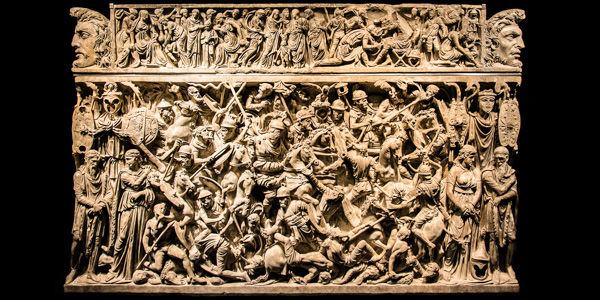
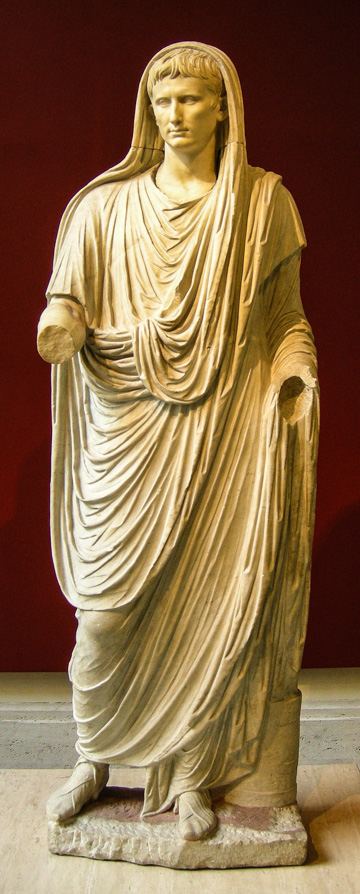
Opened in 1998, this museum simply blows away anything else you'll find in Rome when it comes to Classical-era statues, frescoes, and mosaics.
This is especially true once you consider it is but part of a vast collection called the Museo Nazioanle Romano spread across five Rome spaces, including the nearby Baths of Diocletian and the Palazzo Altemps, near Piazza Navona.
The Palazzo Massimo a veritable "Where have you been all my life?" experience for antiquities buffs, and promises an aesthetically pleasant and informative afternoon even for the mildly curious.
This 19th-century palazzo near Termini train station houses a fully modernized museum of advanced lighting systems, explanatory placards in English, and a curatorial attention to detail heretofore unseen on the dusty old Roman museum scene.
There are no boring ranks of broken marble busts here—portrait busts there are aplenty, but most are masterworks of expression and character, representing famous Romans and giving you an opportunity to put marble faces to the names of all those emperors and other ancient bigwigs.
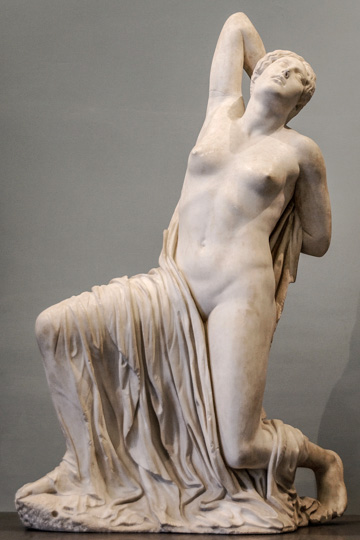
Among them is a statue of Augustus Caesar wearing his toga pulled over his head like a shawl, a sign he had assumed the role of a priest (actually, of the head priest, which in Latin is Pontifex Maximus, a title the Christian popes would later adopt).
Also on the ground floor is an altar from Ostia Antica whose reliefs bear a striking resemblance to 15th-century frescoes of the Nativity
There's also a hauntingly beautiful 440 BC statue of a wounded Niobid, collapsing as she reaches for her back where one of Apollo and Artemis' spiteful arrows struck.
Among the masterpieces up on the first floor are a discus thrower, a bronze Dionysus fished out of the Tiber, bronze bits from ancient shipwrecks on Lake Nemi, and an incredibly well-preserved sarcophagus (pictured above) featuring a tumultuous battle scene between Romans and Germanic barbarians (all from the AD 2nd century).
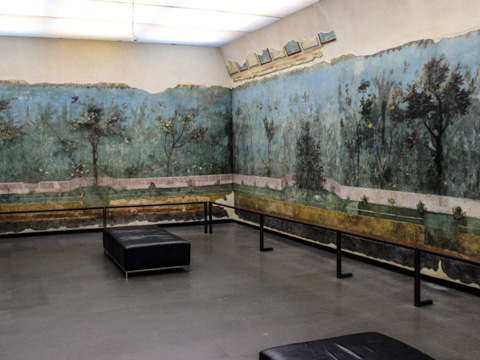
Up on second floor are Roman frescoes, stuccoes, and mosaics spanning the 1st century BC to the AD 5th century, most never seen by the general public since they were discovered in the 19th century.
The frescoes and stuccoes are mainly countryside scenes, decorative strips, and a few naval battles, all carefully restored and reattached into spaces that are faithful to the original dimensions of the rooms from which they came.
They came primarily from two sites: the Augustus' summer villa of "Prima Porta" (AD 1st century), and the ancient "Villa della Farnesina," unearthed near the existing Renaissance Villa Farnesina on the Trastevere banks of the Tiber in the 1870s as they were preparing to build the river embankments.
This 30-20 BC villa—most likely built for general Agrippa to celebrate his marriage to Emperor Augustus' daughter, but probably never actually lived in—was quickly excavated, the frescoes detached, and the whole thing buried in concrete to raise the embankments. The ancient frescoes remained "under restoration" for the next 119 years until this museum opened.
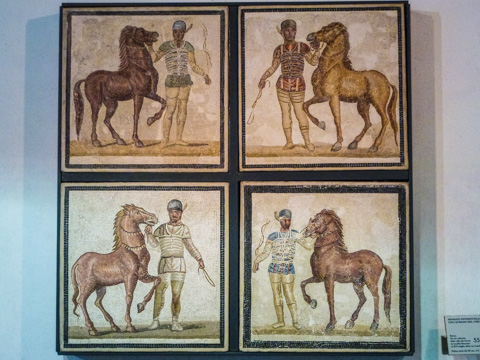
Among the recreated rooms of detached frescoes from the ancient Villa Farnesina is the viridarium, all four walls decorated as if the room were actually a tent with a "view" out to the gardens on all four sides (in reality, it was a sunken space used as a winter dining room so you could pretend it was still spring outdoors).
The best part? This would not look at all out of place in the existing Villa Farnesina, built 1,500 years later, which has a room upstairs with an almost identical theme: the walls frescoed to appear to be open loggias looking out over the surrounding countryside.
Also up here are halls and rooms lined with incredible mosaic scenes, among them the famous Four Charioteers standing with their horses in the four traditional team colors (red, blue, green, and white) that would run the races around the Circus Maximus.
There are also several rare, AD 4th-century opus sectile (marble inlay) scenes from the Basilica of Giunio Bassa.
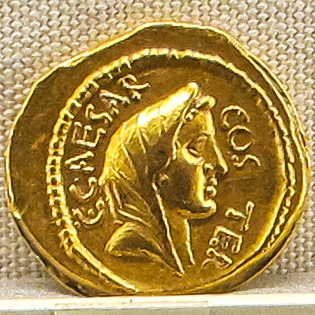
The basement has two sections. The first contains ancient jewelry, gold hair nets, ivory dolls, didactic CD-ROM consoles, and the mummy of an eight-year-old girl.
The second is an oversized vault containing Rome's greatest numismatic collection. It traces Italian coinage from ancient Roman Republic monies through the pocket change of Imperial Rome, medieval Italian empires, and Renaissance principalities, to the Italian lira, the Euro, and a computer live feed of the Italian stock exchange.
Largo di Villa Peretti (where Piazza del Cinquecento—the giant square outside Termini—meets Via Viminale)
tel. +39-06-480-201
archeoroma.beniculturali.it
or
www.coopculture.it
Tues–Sun 9am–7:45pm
€8
Roma Pass: Yes (free, or 35% off)
Bus: 16, 75, 360, 649, C3, 60L, 64, 82, 85, 170, 175, 910, N2, N1, N15, N7, N8, N9, N12, N15, N18
Metro: Termini (AB) or Repubblica (A)
Hop-on/hop-off: Terminal B or Terminal A
Planning your day: Figure on a little less than hour for the ground floor, and the same for the second floor; spend 15 minutes in the basement, and you're at 2–2.5 hours for the whole museum.
Book ahead: You might want to book your tickets ahead of time since you are assigned an entry time to get into the excellent frescoed rooms upstairs (and if you just show up, you might end up having to wait around for several hours before your assigned entry time; if you book ahead, you can pick the time and arrive at a more suitable hour).
The ticket office closes one hour before the museum.
The regular ticket to any one MNR museum includes entry to all branches of the Museo Nazionale Romano for the amazing low price of €7 (you get a week in which to visit them all). However, note that if any branch of the musuem has a special exhibition going (which they almost always do), the ticket price rises to €10.
In other words: Expect admission to be €10, and be pleasantly surprised if they happen to be between exhibitions when you are in town and the price drops to €7.
This is a fantastic deal—though also consider using this as one of the two freebies you get with the Roma Pass (though there are few more expensive sights—the Forum/Colosseum, or the Galleria Borghese—on which you might spend your two "get in free" coupons). » more
I advise against the Archeologia Card,which you will also see offered. This card covers entry to these museums plus the Downtown Ancient Rome group (Roman Forum, the Colosseum, and the Palatine Hill; normally €12), and the Appian Way group (Baths of Caracalla, Tomb of Cecilia Metella, Villa of the Quintili; normally €6).
Sounds good, right? Some major-league sights in there, yes? True: But the savings is actually only €3—and you can get more bang for your sightseeing buck by using the Roma Pass instead to cover the Forum/Colosseum (plus either this group or something else major like the Galleria Borghese). » more
The museum itself offers (free) tours only in Italian.
Take a guided tour of Palazzo Massimo alle Terme in English with one of our partners:
Share this page
Search ReidsItaly.com
Largo di Villa Peretti (where Piazza del Cinquecento—the giant square outside Termini—meets Via Viminale)
tel. +39-06-480-201
archeoroma.beniculturali.it
or
www.coopculture.it
Tues–Sun 9am–7:45pm
€8
Roma Pass: Yes (free, or 35% off)
Bus: 16, 75, 360, 649, C3, 60L, 64, 82, 85, 170, 175, 910, N2, N1, N15, N7, N8, N9, N12, N15, N18
Metro: Termini (AB) or Repubblica (A)
Hop-on/hop-off: Terminal B or Terminal A